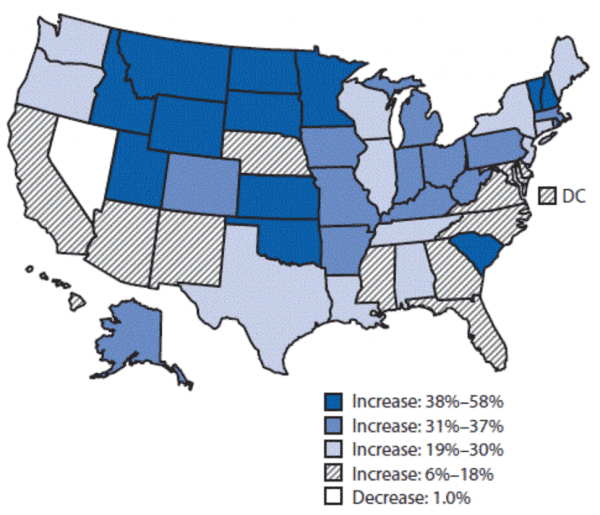
The suicide deaths of chef, author, and TV host Anthony Bourdain and fashion designer Kate Spade this week are stories of lives cut short for reasons we’ll never fully understand. But these anecdotes are also a reminder of a serious public health issue in America that needs far more attention.
According to data from the Centers for Disease Control and Prevention, released on June 7, suicide rates have increased significantly across the US. Between 1999 and 2016, suicide rates rose in nearly every state in the union, with 25 states showing increases of more than 30 percent.
The central and northern parts of the US — North Dakota, Wyoming, Montana, Minnesota — saw some of the greatest rises in suicide rates.

In North Dakota, for example, the suicide death rate increased by nearly 60 percent since 1999. Nevada was the one state that saw no increase — but the rate there remained “consistently high throughout the study period.” The suicide rate in Nevada is currently 21 per 100,000 deaths, greater than the national average of 13 deaths per 100,000. (You can see other state-specific rates here.)
In 2016, nearly 45,000 Americans died by suicide — making it the 10th most common cause of death in the US, and one of only three leading causes that are increasing, according to the CDC.
One of the most disturbing aspects of the report: More than half of the people who died by suicide had no known mental health problems. Instead, the CDC said, “Relationship, substance use, health, and job or financial problems are among the other circumstances contributing to suicide.” Also disturbing: 48 percent of the suicides occurred by firearms — another reminder that while the homicides in America’s gun crisis get a lot of public attention, suicides by gun are far more common.
“At what point is it a crisis?” Nadine Kaslow, a past president of the American Psychological Association, asked the Washington Post. “Suicide is a public health crisis when you look at the numbers, and they keep going up. It’s up everywhere. And we know that the rates are actually higher than what’s reported. But homicides still get more attention.”
The majority of the suicide deaths not linked to mental health problems involved midlife white males
The vast majority of suicides that weren’t linked to a known mental health problem in the CDC study involved middle-aged white males — yet another reflection of a growing tragedy in the US.
Life expectancy keeps dropping in the US, and researchers have explained the decline, in part, by an increase in “deaths of despair”: suicides, alcoholism, and drug overdoses, particularly from opioid painkillers, are a rising problem for midlife white people.
If you or anyone you know is considering suicide or self-harm or is anxious, depressed, upset, or needs to talk, there are people who want to help:
In the US:
Crisis Text Line: Text START to 741741 from anywhere in the USA, at any time, about any type of crisis
The National Suicide Prevention Lifeline: 1-800-273-8255
The Trevor Project: 1-866-488-7386
Outside the US:
The International Association for Suicide Prevention lists a number of suicide hotlines by country. Click here to find them.
Befrienders Worldwide
Along with worsening job prospects over the past several decades, this group has seen their chances of a stable marriage and family decline, as well as their overall health. To manage their despair about the gap between their hopes and what’s come of their lives, they’ve often turned to drugs, alcohol, and self-harm.
Meanwhile, gains in fighting heart disease have stalled as rates of obesity and diabetes have ploddingly climbed.
So the rise in mortality for white midlife people in America since the late 1990s is actually the final stage of a decades-long process. “It’s about the collapse of white middle class,” Princeton University’s Anne Case told Vox. And that’s helping drive suicide trends.
Sometimes when we hear a trend is “on the rise,” our brains translate that to “everyone is doing it.” Because we are very sensitive to information about what’s normal, it’s important to note: While suicide is the tenth leading cause of death, it’s still rare, and it ought to be rarer, as I reported with my colleague Brian Resnick.
To prevent suicide deaths, a couple of things are clear: Countries that have made it more difficult to access firearms have seen their suicide rates decline. So the evidence suggests that addressing America’s gun problem would certainly help. The CDC report also calls for a comprehensive approach to prevention, including “strengthening economic supports” through housing and financial policies, and “promoting social connectedness.”
“Suicidologists regularly state that suicide is not caused by a single factor,” the CDC said. And as this new report clearly shows, the causes of suicide are much broader than just mental health conditions. We need suicide prevention policies and strategies that reflect that.
Related
How to help someone who might be at risk of suicide
Sourse: vox.com






